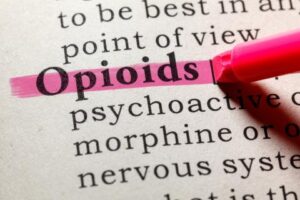Welcome to our guide on opioid use disorder (OUD) and the diagnostic criteria outlined in the Diagnostic and Statistical Manual of Mental Disorders, Fifth Edition (DSM-5). OUD is a complex condition characterized by problematic patterns of opioid use, leading to significant impairment or distress. It’s crucial to understand the DSM-5 criteria for opioid use disorder as it helps clinicians, researchers, and individuals affected by this disorder to identify, assess, and address the condition effectively.
Contents
What is Opioid Use Disorder?
 Opioid Use Disorder (OUD) is a chronic medical condition characterized by the compulsive use of opioids despite adverse consequences. Opioids are a class of drugs that include prescription pain relievers like oxycodone, hydrocodone, and morphine, as well as the illegal drug heroin. Individuals with OUD often struggle to control their opioid use, leading to a range of physical, psychological, and social problems.
Opioid Use Disorder (OUD) is a chronic medical condition characterized by the compulsive use of opioids despite adverse consequences. Opioids are a class of drugs that include prescription pain relievers like oxycodone, hydrocodone, and morphine, as well as the illegal drug heroin. Individuals with OUD often struggle to control their opioid use, leading to a range of physical, psychological, and social problems.
The hallmark of OUD is the inability to control opioid use. And, coupled with a strong craving for the drug. This craving can drive individuals to engage in risky behaviors such as doctor shopping, stealing, or illegal drug trafficking to obtain opioids. Moreover, continued opioid use can lead to tolerance, where higher doses are needed to achieve the desired effect, as well as withdrawal symptoms when drug use is reduced or stopped.
What Is The DSM 5 Criteria For Opioid Use Disorder?
The Diagnostic and Statistical Manual of Mental Disorders, Fifth Edition (DSM-5), outlines specific criteria for diagnosing Opioid Use Disorder (OUD). To meet the DSM 5 criteria for opioid use disorder, an individual must exhibit at least two of the following symptoms within 12 months. Then, this may indicate problematic opioid use.
1. Taking opioids in larger amounts or over a longer period than intended
Individuals with OUD may frequently use opioids in larger quantities or for longer durations than originally intended. And, indicating a loss of control over their drug use.
2. Persistent desire or unsuccessful efforts to cut down or control opioid use
Despite attempts to reduce or stop opioid use, individuals with OUD may find it challenging to control their cravings or impulses to use opioids. Eventually, this leads to unsuccessful efforts to quit.
3. Significant time spent obtaining, using, or recovering from the effects of opioids
Opioid use can consume a substantial amount of time, with individuals preoccupied with obtaining opioids, using them, or recovering from their effects. This is often at the expense of other important activities.
4. Craving or a strong desire to use opioids
Individuals with OUD may experience intense cravings for opioids. And, leading to a strong desire to use the drug even when they are not actively using it.
5. Continued opioid use despite recurrent social or interpersonal problems caused by the effects
Opioid use can lead to significant social and interpersonal problems, including conflicts with family members, friends, or colleagues, yet individuals with OUD continue to use opioids despite these issues.
6. Important social, occupational, or recreational activities given up or reduced because of opioid use
Opioid use can interfere with various aspects of an individual’s life, causing them to neglect or reduce their participation in social, occupational, or recreational activities that were once important to them.
7. Recurrent opioid use in situations where it is physically hazardous
Despite the risks associated with opioid use, individuals with OUD may continue to use opioids in situations where it could lead to physical harm. This can include driving under the influence or operating heavy machinery while intoxicated.
8. Tolerance
Individuals with OUD may develop tolerance to the effects of opioids. And, requiring higher doses to achieve the desired effects.
9. Withdrawal
Abrupt cessation of opioid use or reduction in dosage can lead to withdrawal symptoms. This may include dysphoric mood, nausea or vomiting, muscle aches, diarrhea, and other physical symptoms.
The severity of OUD is classified as mild, moderate, or severe, depending on the number of symptoms present. It’s important to note that OUD is a treatable condition. Individuals who meet the DSM 5 criteria for opioid use disorder should seek professional help for assessment, diagnosis, and appropriate treatment.
What Is The Diagnosis Code For Opioid Use Disorder?
 In the International Classification of Diseases, Tenth Revision, Clinical Modification (ICD-10-CM), the diagnosis code for opioid use disorder is F11.9. This code is used to classify and document cases of opioid use disorder in medical records, billing, and statistical purposes.
In the International Classification of Diseases, Tenth Revision, Clinical Modification (ICD-10-CM), the diagnosis code for opioid use disorder is F11.9. This code is used to classify and document cases of opioid use disorder in medical records, billing, and statistical purposes.
It’s important to note that the ICD-10-CM code F11.9 represents a general category for opioid use disorder and does not specify the severity level (mild, moderate, or severe) or any additional clinical details. Further documentation and coding may be necessary to accurately capture the severity and other relevant aspects of the disorder for proper treatment, billing, and reporting purposes.
What Are The Challenges With Diagnosis?
Diagnosing opioid use disorder (OUD) can present several challenges due to its complex nature and the stigma surrounding substance use disorders.
Challenges
Some of the key challenges include:
Underreporting and Stigma
The stigma surrounding substance use disorders can lead individuals to underreport their symptoms or avoid seeking help altogether. Fear of judgment, discrimination, or legal consequences may prevent individuals from disclosing their opioid use or seeking appropriate treatment.
Co-occurring Disorders
OUD often co-occurs with other mental health disorders such as depression, anxiety, or post-traumatic stress disorder (PTSD). Untangling the symptoms of OUD from those of co-occurring disorders can be challenging and may require comprehensive assessment by healthcare professionals.
Misinterpretation of Symptoms
Some symptoms of OUD, such as tolerance and withdrawal, can overlap with those of other medical conditions or medication side effects. This can lead to misinterpretation of symptoms and delay in accurate diagnosis and treatment.
Variability in Presentation
OUD can manifest in various ways and its presentation can vary widely among individuals. Some individuals may exhibit classic symptoms of addiction, while others may appear to function normally despite significant opioid use. This variability in presentation can complicate the diagnostic process.
Limited Screening and Assessment Tools
While there are screening tools available to assess for OUD, they may not capture the full spectrum of the disorder or account for individual differences. Additionally, healthcare settings may lack standardized protocols for screening and assessing OUD, leading to inconsistencies in diagnosis and treatment.
Access to Healthcare Services
 Limited access to healthcare services, particularly in underserved areas, can pose a barrier to timely diagnosis and treatment of OUD. This is exacerbated by disparities in healthcare access and resources, which may disproportionately affect certain populations, such as rural or low-income communities.
Limited access to healthcare services, particularly in underserved areas, can pose a barrier to timely diagnosis and treatment of OUD. This is exacerbated by disparities in healthcare access and resources, which may disproportionately affect certain populations, such as rural or low-income communities.
Addressing these challenges requires a multifaceted approach. This might include destigmatizing substance use disorders, increasing awareness and education among healthcare professionals, improving access to comprehensive screening and assessment tools, and more. By addressing these challenges, healthcare systems can better identify and support individuals with OUD.
Conclusion
In conclusion, understanding DSM 5 criteria for opioid use disorder (OUD) sheds light on the complexities of this condition. By recognizing the signs and symptoms outlined in the criteria, individuals, healthcare professionals, and communities can work together to identify and address OUD effectively. Despite the challenges in diagnosis, including stigma and variability in presentation, it’s crucial to destigmatize substance use disorders and provide support to those affected.
With a comprehensive approach that includes screening, assessment, and evidence-based treatment, we can empower individuals with OUD. And, help to embark on a journey of recovery, leading to improved health and well-being for all.
